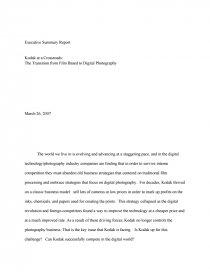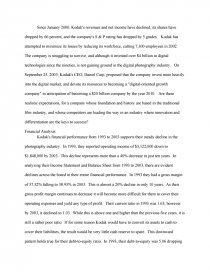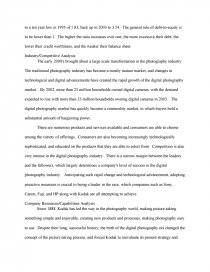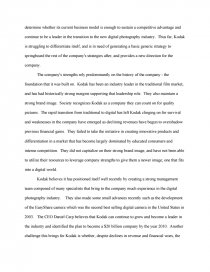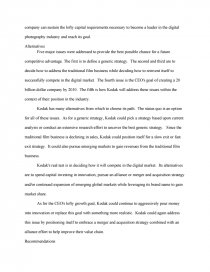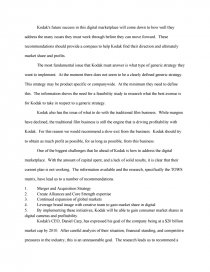Kodak At The Digital Crossroads
Essay by 24 • April 17, 2011 • 1,966 Words (8 Pages) • 1,848 Views
Executive Summary Report
Kodak at a Crossroads:
The Transition from Film Based to Digital Photography
March 26, 2007
The world we live in is evolving and advancing at a staggering pace, and in the digital technology/photography industry companies are finding that in order to survive intense competition they must abandon old business strategies that centered on traditional film processing and embrace strategies that focus on digital photography. For decades, Kodak thrived on a classic business model: sell lots of cameras at low prices in order to mark up profits on the inks, chemicals, and papers used for creating the prints. This strategy collapsed as the digital revolution and foreign competitors found a way to improve the technology at a cheaper price and at a much improved rate. As a result of these driving forces, Kodak no longer controls the photography business. That is the key issue that Kodak is facing. Is Kodak up for this challenge? Can Kodak successfully compete in the digital world?
Since January 2000, Kodak's revenues and net income have declined, its shares have dropped by 66 percent, and the company's S & P rating has dropped by 5 grades. Kodak has attempted to minimize its losses by reducing its workforce, cutting 7,300 employees in 2002. The company is struggling to survive, and although it invested over $4 billion in digital technologies since the nineties, is not gaining ground in the digital photography industry. On September 25, 2003, Kodak's CEO, Daniel Carp, proposed that the company invest more heavily into the digital market, and devote its resources to becoming a "digital-oriented growth company" in anticipation of becoming a $20 billion company by the year 2010. Are these realistic expectations, for a company whose foundation and history are based in the traditional film industry, and whose competitors are leading the way in an industry where innovation and differentiation are the keys to success?
Financial Analysis
Kodak's financial performance from 1993 to 2003 supports their steady decline in the photography industry. In 1993, they reported operating income of $3,122,000 down to $1,848,000 by 2003. This decline represents more than a 40% decrease in just ten years. In analyzing their Income Statement and Balance Sheet from 1993 to 2003, there are evident declines across the board in their entire financial performance. In 1993 they had a gross margin of 57.52% falling to 38.95% in 2003. This is almost a 20% decline in only 10 years. As their gross profit margin continues to decrease it will become more difficult for them to cover their operating expenses and yield any type of profit. Their current ratio in 1993 was 1.63; however by 2003, it declined to 1.03. While this is above one and higher than the previous five years, it is still a rather poor ratio. If for some reason Kodak would have to convert its assets to cash to cover their liabilities, the result would be very little cash reserve to spare. This downward pattern holds true for their debt-to-equity ratio. In 1993, their debt-to-equity was 5.06 dropping to a ten year low in 1995 of 1.83, back up in 2003 to 3.54. The general rule of debt-to-equity is to be lower than 1. The higher the ratio increases over one, the more excessive their debt, the lower their credit worthiness, and the weaker their balance sheet.
Industry/Competitive Analysis
The early 2000's brought about a large scale transformation in the photography industry. The traditional photography industry has become a mostly mature market, and changes in technological and digital advancements have created the rapid growth of the digital photography market. By 2002, more than 23 million households owned digital cameras, with the demand expected to rise with more than 33 million households owning digital cameras in 2003. The digital photography market has quickly become a commodity market, in which buyers hold a substantial amount of bargaining power.
There are numerous products and services available and consumers are able to choose among the variety of offerings. Consumers are also becoming increasingly technologically sophisticated, and educated on the products that they are able to select from. Competition is also very intense in the digital photography industry. There is a narrow margin between the leaders and the followers, which largely determines a company's level of success in the digital photography industry. Anticipating such rapid change and technological advancement, adopting proactive measures is crucial to being a leader in the race, which companies such as Sony, Canon, Fuji, and HP along with Kodak are all attempting to achieve.
Company Resources/Capabilities Analysis
Since 1888, Kodak has led the way in the photography world, making picture-taking something simple and enjoyable, creating new products and processes, making photography easy to use. Despite their long, successful history, the birth of the digital photography era changed the concept of the picture taking process, and forced Kodak to reevaluate its present strategy and determine whether its current business model is enough to sustain a competitive advantage and continue to be a leader in the transition to the new digital photography industry. Thus far, Kodak is struggling to differentiate itself, and is in need of generating a basic generic strategy to springboard the rest of the company's strategies after, and provides a new direction for the company.
The company's strengths rely predominantly on the history of the company - the foundation that it was built on. Kodak has been an industry leader in the traditional film market, and has had historically strong margins supporting that leadership role. They also maintain a strong brand image. Society recognizes Kodak as a company they can count on for quality pictures. The rapid transition from traditional to digital has left Kodak clinging on for survival and weaknesses in the company have emerged as declining revenues have begun to overshadow previous financial gains. They failed to take the initiative in creating innovative products and differentiation in a market that has become largely dominated by educated consumers and intense competition. They did not capitalize on their strong brand image, and have not been able to utilize their resources to leverage company strengths
...
...
